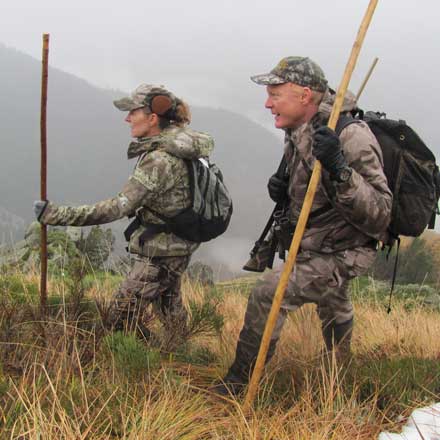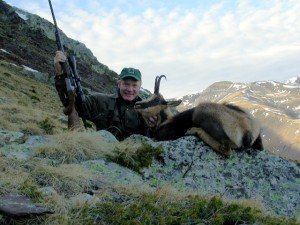
I’ve written before that all mountain hunting is somewhat similar, a matter of climbing, glassing, and figuring out how to get close enough for a shot. The difficulty always depends on local game density, the characteristics of a given mountain range, and ofcourse, your luck. I’ve also written that most of the world’s wild goats are more difficult quarry than most of the world’s wild sheep. Goats are often found higher than sheep, and even more frequently in country that’s rougher, steeper, and more dangerous than any self-respecting sheep would call home.
This applies to all goats, including the smallest of the world’s wild goats, the petite little chamois of Europe and western Asia. European wildlife has been managed intensively for centuries, and most European hunts are essentially a harvest, conducted in the company of an experienced gamekeeper. Typically, the proper animal to take is designated based on tight management criteria, with permits often specifying age group as well as sex. This applies to chamois and ibex as well as the antlered game, and while relatively little European hunting is “canned,” so to speak, most hunts are successful.
In the planning stages, it can t be all too easy to underestimate a Europeanhunt. They aren’t all easy, and they aren’t all successful, and the little chamois may beconsistently, Europe’s most challenging game animal. This was brought home to me in spades just last week when my wife, Donna, and I got our butts kicked, literally and figuratively, on a chamois hunt in the French Pyrenees! We were in a national reserve, and on public land, most European permits have a shelf life. Our permit was good forthree days, which is a common number, but many such permits are good for just two,or occasionally, one hunting day.
This means you’re banking on the weather. Any hunt can get rained out, and on mountain hunts, you can get snowed or fogged out. My first attempt for Gredos ibexin Spain was fogged out completely. The system isn’t unfair; if you can’t hunt, yougenerally don’t pay—but there usually isn’t any rain check. On this chamois hunt, we
had rain, snow, and fog, but we were able to hunt. Oh, boy, did we hunt. We sweated our way up to the tallest ridges, collecting an impressive collection of world-class blisters on steep, rain-sodden slopes—and bruises and scrapes from slipping on icy rocks. We saw lots of chamois, too, but we never closed the deal....
We got one chance only, at midmorning on the second day. It was a 260-yard poke that was very “do-able”—but never a sure thing on these nervous little animals usually taken with radical uphill-downhill shots. At the time, I wasn’t worried. Missing a chamois isn’t all that unusual and certainly no great shame. There were plenty of animals, and I figured there would be more chances. Nope, that was it!

It was a very good lesson in humility and the principles of Murphy’s Law. I wish they were altogether my lessons (which, like every other hunter, I need to relearn periodically). In this case the permit was Donna’s, so the lessons (and the worst of the blisters and bruises) were mostly hers. We did it that way because I took a Pyrenean chamois a few years ago, and we figured this was her turn.
When I got mine, we hunted on the Spanish side of the Pyrenees. It was high, steep, and very cold. Even so, it should have been an easy hunt. I complicated things when I missed a straight downhill shot in easy range at midmorning (oops!), and then missed another long poke at midday. The afternoon turned into a bit of an ordeal, but I took a very nice male shortly before dark. So it wasn’t easy, with much of the difficulty self-inflicted, but it was still a one-day hunt. I figured my hunt for that particular chamois was fairly typical, or at least that’s the way I saw it at the time. Now I’m not so sure which of us had the more typical hunt!
Depending on which authority to which you adhere, there are eight or nine varieties of chamois from northwestern Spain to Russia’s Caucasus, plus Alpine chamois introduced to New Zealand’s Southern Alps. The genus is Rupicapra, aptly translated as “rock goat,” with both males and females growing very similar horns (like our Rocky Mountain goat, to which the chamois are distantly related).
The westernmost varieties are R. pyrenaica, the Pyrenean chamois just discussed and the Cantabrian chamois of the mountain of northwestern Spain. These two are the smallest of the chamois. The Cantabrian is the smallest of all with more yellow-gold pelage on neck and chest. The rest of the chamois are species R. rupicapra, with mature...
males tending to be very black in the body with pale yellow or white face masks. The subspecies are identified as being localized in specific mountain ranges—Alpine, Carpathian, Balkan, Anatolian (in Turkey) and Caucasian. They are virtually indistinguishable, except they do get slightly bigger in both body and horn as you move
from west to east. My experience suggests that the smallest, the Cantabrian, won’t weigh much more than 40 pounds, while the Carpathian, Balkan, and Anatolian (which I have hunted; I haven’t hunted Caucasian chamois as well) could weigh twice as much).

None are easy. After all, they’re mountain goats! They love steep, rough stuff. They seem to move around quite a bit more than ibex and our own mountain goats, which makes spotting and stalking difficult. You spot them from afar, of course, but all toooften you make a terrible climb only to find they’ve moved! When it rains or snows, which it does frequently in all chamois mountains, they tend to drop down into the timber, where it’s almost impossible to hunt them.
Still, over the years, like so much European hunting, all of my chamois hunts have been (eventually) successful. Not necessarily easy. In Romania, for the Carpathian chamois: in Macedonia, for the Balkanchamois; in eastern Turkey for the Anatolian chamois, I fought deep snows and whiteout conditions in serious mountains—but I eventually won. So this recent hunt in the French Pyrenees is, honestly, the first time I ever got beat on a chamois hunt. I wouldn’t have wished it on Donna, but the experience gave me new respect for the classy little rock-goat of the Old World. Uncertainty is, after all, part and parcel to the hunting experience, so maybe it was a good lesson—and perhaps it explains, in part, why European hunters have such reverence for their little chamois!